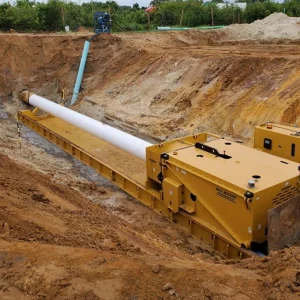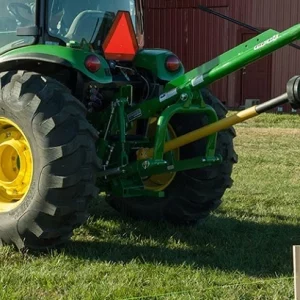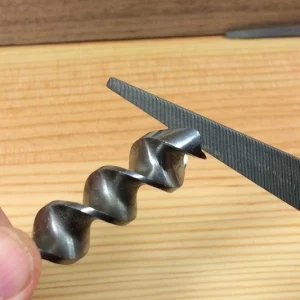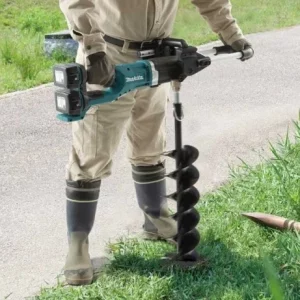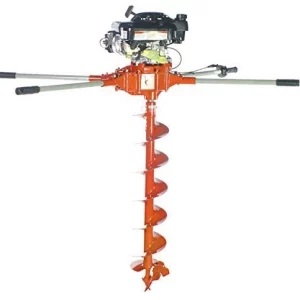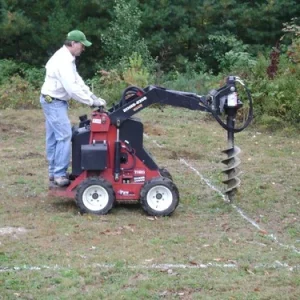When it comes to drilling tasks that demand efficiency and precision, auger drills have established themselves as indispensable tools. Auger drills offer a unique approach to drilling, featuring a helical screw blade known as an auger that helps cut through various materials with ease. From construction sites to agriculture, and even in scientific research, auger drills have proven their versatility across a wide range of applications.
In this comprehensive blog, we’ll delve into the world of auger drills, exploring their mechanics, applications, and the benefits they bring to different industries. Whether you’re a DIY enthusiast, a professional in construction, or simply curious about the mechanics of these ingenious devices, this overview will provide valuable insights into the inner workings and practical uses of auger drills. Join us as we uncover the fascinating world of auger drills and discover how they continue to shape and streamline numerous tasks across industries.
Modern Auger Drill Innovations
The leap from manual labor to mechanized drilling ushered in a new era for auger drills. Today’s auger drills are a symphony of engineering, boasting features like variable speeds, interchangeable bits, and even self-driving mechanisms. These advancements have expanded their utility, bringing us to our burning question about concrete.
These technological leaps have expanded the utility of auger drills across various industries, from construction to agriculture and beyond. However, the burning question at hand pertains to their application in concrete drilling. While modern auger drills boast impressive features, their compatibility and effectiveness in concrete drilling depend on factors such as drill bit design, motor power, and the specific composition of the concrete.
The Nature of Concrete
Composition of Concrete: Concrete is primarily composed of three main ingredients: cement, water, and aggregates. The interaction between these components is what gives concrete its unique properties.
Cement: Cement is a binding agent that holds the other components together. It reacts with water to form a paste that hardens over time, providing the strength and rigidity of the final concrete structure.
Water: Water is necessary for the chemical reaction with cement known as hydration. The right amount of water is crucial to achieve the desired consistency and strength. Too much water can weaken the final product, while too little can make it difficult to work with.
Aggregates: Aggregates are granular materials like sand, gravel, crushed stone, or recycled materials that provide bulk and strength to the concrete. The choice of aggregates and their grading can significantly impact the final characteristics of the concrete, including its strength, durability, and workability.
Concrete Strength
Concrete can be categorized into various types based on its strength, density, and intended use. The strength of concrete is typically measured in terms of its compressive strength, which is the ability of the material to withstand axial loads pushing against it. Here are some varieties of concrete strength:
Normal Strength Concrete: This is the most common type of concrete used in general construction. It typically has a compressive strength in the range of 20 to 40 megapascals (MPa). It’s suitable for most residential and commercial applications.
High-Strength Concrete: High-strength concrete is designed to have significantly higher compressive strength, often exceeding 40 MPa. It’s used in applications where increased load-bearing capacity is required, such as in high-rise buildings and bridges.
Ultra-High Performance Concrete (UHPC): UHPC is a relatively new development in concrete technology. It has an exceptionally high compressive strength, often exceeding 100 MPa. UHPC is used in specialized applications where extreme strength and durability are crucial.
Lightweight Concrete: Lightweight concrete is formulated with lightweight aggregates, such as expanded shale or clay, to reduce its density. It’s suitable for applications where weight reduction is important, such as in precast concrete elements and insulating roof structures.
Self-Consolidating Concrete (SCC): SCC is designed to flow and fill formwork under its own weight, without the need for mechanical vibration. It’s used in situations where complex or congested reinforcement arrangements are present.
Fiber-Reinforced Concrete: This type of concrete includes discrete fibers, such as steel, glass, or synthetic fibers, to enhance its toughness and crack resistance. It’s often used in industrial floors, pavements, and precast elements.
Decorative Concrete: While not defined by strength, decorative concrete involves adding pigments, stamps, or other treatments to enhance its aesthetic appeal. It’s commonly used for driveways, patios, and interior flooring.
Can Auger Drill Through Concrete?
Can it drill? Yes, but only with caveats. The efficacy of an auger drill in penetrating concrete is influenced by the drill’s power, the bit’s material and design, and the concrete’s composition. An auger drill is not typically capable of drilling through solid concrete. Concrete is a dense and hard material that requires specialized tools such as rotary hammer drills or diamond-tipped core drills to effectively penetrate. Auger drills are better suited for softer materials like soil, wood, or some types of masonry.
Factors Influencing Drilling
Techniques for Drilling Concrete with Auger
Drilling through concrete is no walk in the park. It demands technique. Gentle pressure, regular bit cooling, and periodic withdrawal to remove debris can make the process smoother. Here are some expert tips to handle
- Apply gentle pressure to avoid overheating the bit and ensure a controlled drilling pace.
- Regularly cool the drill bit to prevent excessive heat buildup, which can dull the bit and damage the concrete.
- Periodically withdraw the bit from the hole to clear accumulated debris, maintaining efficient progress.
- Utilize appropriate drill bits designed for masonry or concrete to ensure effective penetration.
- Consider using a hammer drill or rotary hammer for improved performance in concrete drilling.
- Adequate safety measures, such as wearing goggles and gloves, are essential to protect against debris and vibrations.
- Pre-mark the drilling spot and use a pilot hole to enhance accuracy and prevent bit wandering.
- Secure the workpiece to prevent movement during drilling and ensure a precise outcome.
- Patience and a steady hand are key; rushing the process can lead to reduced effectiveness and bit damage.
Softer Concrete or Masonry: In situations where the concrete is relatively soft or has a lower strength, an auger drill might be able to create holes for smaller diameter applications like anchors or screws. Pilot Holes: Auger drills can be used to create pilot holes in softer concrete or mortar before inserting fasteners or anchors, aiding in accurate placement. Cable or Pipe Installation: Auger drills could potentially be used to create holes in softer concrete for the installation of cables, pipes, or conduits in less demanding applications. Limited Access: If the space is constrained, an auger drill might be used to create holes where other larger drilling equipment cannot reach. Reduced Dust Generation: Auger drilling might generate less dust compared to some other drilling methods, which could be beneficial in certain environments. Quick Setup: Auger drills are often easy to set up and use, making them suitable for smaller-scale drilling tasks in relatively softer concrete. Versatility: Auger drills can be versatile tools used for various drilling tasks in different materials, though they might not be the first choice for drilling through solid concrete.Benefits of Using Auger Drills on Concrete
Challenges and Solutions
Drilling through concrete is a task that demands precision and the right equipment. While it might seem straightforward, several challenges can arise during the process. Being aware of these challenges and having strategies to address them is essential for achieving successful outcomes:
Bit Wear and Dullness
- Challenge: Drilling through concrete can quickly wear down drill bits, reducing their effectiveness and slowing down progress.
- Solution: Use high-quality carbide-tipped or diamond-tipped drill bits specifically designed for concrete drilling. Replace worn bits promptly to maintain efficiency.
Overheating
- Challenge: Friction generated during drilling can cause the drill bit to overheat, leading to decreased performance and potentially damaging the bit.
- Solution: Implement gentle pressure and a controlled drilling pace to reduce friction. Regularly cool the drill bit by pulling it out of the hole to allow air circulation and dissipate heat.
Debris Accumulation:
- Challenge: Concrete drilling generates debris that can clog the hole and hinder drilling progress.
- Solution: Periodically withdraw the drill bit from the hole to clear accumulated debris. Using a vacuum attachment can help maintain a clean drilling environment.
Bit Wandering:
- Challenge: When starting a hole on a smooth concrete surface, the drill bit can wander and create an off-center hole.
- Solution: Mark the drilling spot with a center punch or a small divot before starting to drill. This provides a guide for the bit and helps prevent wandering.
Noise and Vibration:
- Challenge: Concrete drilling can produce significant noise and vibrations, potentially causing discomfort and fatigue.
- Solution: Wear appropriate personal protective equipment (PPE) such as ear protection and gloves to mitigate the impact of noise and vibrations on the operator.
Structural Integrity:
- Challenge: Drilling through concrete in load-bearing or critical areas can compromise the structural integrity of the material.
- Solution: Carefully assess the drilling location and depth. For critical applications, consult with structural engineers and follow recommended guidelines.
Dust Generation:
- Challenge: Drilling through concrete can generate dust, posing health risks and creating a messy work environment.
- Solution: Use dust collection systems or water suppression methods to control dust. Wear respiratory protection and maintain proper ventilation.
Breakouts and Chipping:
- Challenge: When drilling through concrete, particularly on the exit side, breakouts or chipping can occur, leading to uneven holes.
- Solution: Use a sacrificial backing or drilling from both sides of the concrete to minimize breakout. Gradually increase pressure as the bit penetrates to reduce chipping.
Choosing the Right Equipment:
- Challenge: Using the wrong type of drill or drill bit can result in subpar performance and frustration.
- Solution: Select the appropriate equipment, such as rotary hammer drills or diamond core drills, designed for concrete drilling. Match the bit type to the material hardness.
Tips to Overcome Challenges
Regular maintenance, choosing the right bit, and employing the correct technique are essential. Remember, patience is the name of the game!
- Regular Bit Maintenance: Keep your drill bits in optimal condition by sharpening or replacing them as needed to ensure efficient drilling and prevent excessive wear.
- Select the Right Bit: Choose the appropriate type of drill bit for concrete drilling, such as carbide-tipped or diamond-tipped bits, based on the hardness of the concrete.
- Cooling and Lubrication: Use a water cooling system or apply a coolant to the bit to reduce heat buildup, minimize wear, and extend the life of the drill bit.
- Controlled Pressure: Apply gentle and consistent pressure while drilling to prevent overheating and maintain a controlled drilling pace.
- Proper Technique: Use the correct drilling technique, especially when starting a hole, to prevent bit wandering and ensure a centered hole.
- Pilot Holes: Create pilot holes with smaller bits before using larger ones to help guide the larger bit and prevent chipping.
- Withdrawal for Debris: Periodically pull out the drill bit to remove accumulated debris from the hole, ensuring smoother and more efficient drilling.
- Backside Support: When drilling through concrete, use a sacrificial backing or drill from both sides to minimize breakout or chipping.
- Safety Gear: Wear appropriate personal protective equipment (PPE), such as safety goggles, ear protection, gloves, and a dust mask, to safeguard against debris, noise, and dust.
- Work Environment: Ensure proper lighting and ventilation in your work area for better visibility and comfort during drilling.
- Proper Anchoring: For critical applications, consult structural engineers to determine the appropriate anchoring methods that maintain the structural integrity of the concrete.
- Patience: Approach the task with patience, maintaining a steady hand and pace to achieve accurate and controlled drilling.
- Quality Equipment: Invest in high-quality drilling equipment and tools to improve performance, reliability, and safety.
- Guidelines and Recommendations: Follow manufacturer guidelines and recommendations for the specific drill, drill bits, and drilling technique.
Safety Consideration
Protective Equipment: Safety goggles, ear protection, and dust masks are indispensable. Protecting oneself is as vital as the task at hand.
Safe Drilling Practices: From ensuring a stable drilling platform to being aware of embedded reinforcements, safe drilling practices can’t be emphasized enough.
Alternatives to Auger Drills for Concrete
- Rotary Hammers: These power tools, with their pulsating action, are a popular choice for drilling through concrete.
- Diamond Core Drills: For larger holes and harder concrete, diamond core drills, with their diamond-embedded bits, are a formidable option.
Cost-Effectiveness:
- Initial Investment: While the upfront cost of auger drills might appear significant, their efficiency and durability often justify the investment over time.
- Longevity: High-quality auger drills can last for many drilling tasks, reducing the need for frequent replacements and ultimately saving money.
Return on Investment:
- Versatility: Auger drills offer a wide range of applications, making them a valuable tool for professionals in construction and related industries.
- Time Savings: The speed and ease of auger drilling can lead to increased productivity and more completed projects, translating into higher revenue.
Ecological Footprint of Drilling:
- Noise and Debris: Drilling operations generate noise and debris, which can impact the local environment and ecosystem.
- Resource Consumption: The energy required for drilling and the disposal of debris can contribute to the ecological footprint of the activity.
Sustainable Drilling Practices:
- Waste Management: Proper disposal and recycling of drilling debris can minimize the impact on landfills and natural surroundings.
- Noise Reduction: Using quieter drilling equipment or implementing noise barriers can reduce disturbances to local communities.
- Dust Control: Employing dust collection systems or wet drilling techniques can mitigate airborne particles and improve air quality.
- Efficient Equipment: Well-maintained and properly calibrated drilling equipment can reduce energy consumption and emissions.
- Site Restoration: After drilling, restoring the site to its original condition helps minimize long-term environmental impacts.
FAQs on Can Auger Drill Through Concrete
An auger drill is a drilling device characterized by its helical drill bit, primarily used for boring holes in various materials. It’s always recommended to understand the basics and safety precautions before attempting to drill through concrete or any other material. Both have their merits. While auger drills offer precision, rotary hammers are known for their power, especially when dealing with harder concrete. Regular maintenance, like cleaning and lubricating, should be done after every use, especially if used extensively. Yes, sustainable drilling involves waste management, noise control, and energy-efficient equipment. Signs like decreased efficiency, visible wear, and frequent overheating can indicate it’s time for a replacement.What is an auger drill?
Is it safe to drill through concrete without prior knowledge?
Which is better: auger drill or rotary hammer for concrete?
How often should I maintain my auger drill?
Are there eco-friendly drilling practices?
How do I recognize when my auger drill bit needs replacement?
Conclusion
The journey from understanding auger drills to comprehending their capability with concrete has been enlightening.
The essence lies in the intertwining of knowledge, technique, and the right tools. While challenges exist, with care and understanding, the question, “Can Auger Drill Through Concrete?” gets a resounding “Yes, it can!” from experts. Challenges encountered, like overheating or debris, are transformed into stepping stones for growth as professionals adeptly navigate the complexities with well-maintained tools, strategic cooling methods, and safety precautions.
Culminating with a resounding affirmation from experts, this journey illuminates the harmony achievable when human ingenuity harmonizes with the right tools, showcasing the art of transforming challenges into accomplishments.


